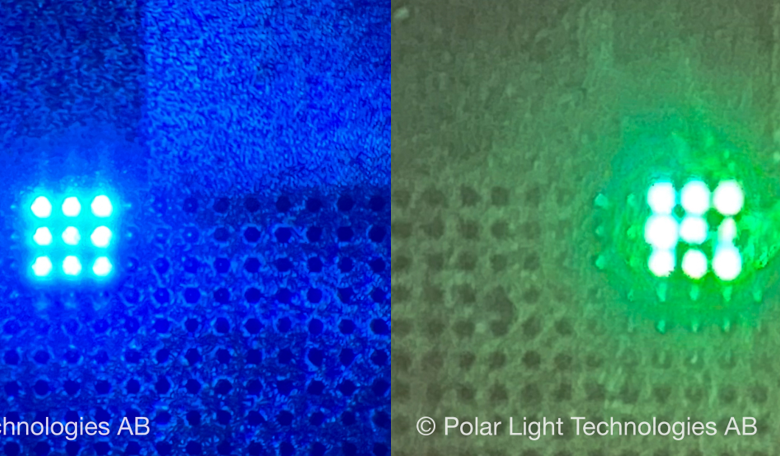Blue and green light

A revolution in blue and green light at the micro level
In the summer of 2023, a highly controlled blue light from Polar Light Technologies’ microLEDs in the shape of small pyramids appeared for the first time. Short after, also a highly controlled green light was achieved. The breakthrough could mean a revolution in the global display market, which is about to undergo a transformation – both in terms of technology and sustainability.
Micro LED (μLED) is the next generation of LED technology, commonly known as light-emitting diodes. The diodes have unique properties in terms of small dimensions (down to microns), high brightness and efficiency, and are expected to eventually replace older technologies in existing displays.
Ivan Martinovic, Chief Product Officer and co-founder of Polar Light Technologies, explains that hundreds of millions of microLEDs can fit on the tip of your finger:
“This makes them particularly important for AR applications such as head-up displays and head-mounted-displays, sometimes referred to as Spatial Computing.”
Using RISE clean room labs
Polar Light Technologies was founded in 2014, by Professor Per Olof Holtz, based on research into nanostructures in semiconductor materials at Linköping University. In the last three years the company has made significant progress. This includes a collaboration with RISE (Swedish research institute and innovation partner), using its cleanroom laboratories in Kista and Lund.
“Having access to RISE’s epitaxy expertise has been an success factor for us. The use of the MOCVD tool in Lund has resulted in a much higher quality of our quantum structures, which are the light emitting component in our micro-LEDs”, says Lisa Rullik, CTO.
New manufacturing process for micro-LEDs
The Polar Light’s microLEDs involves many different process steps in a clean room environment, and the pyramidal structures are a novelty in LED manufacturing. The Polar Light solution is based on a completely new manufacturing process:
- The first pyramidal micro-LEDs that offer the highest optical performance even before optimization: 4 um pyramidal LEDs with a brightness of 2.9 MNits at 470 nm.
- A unique hybridization technology to integrate the LED front plane with the back plane
“We are very happy and proud to have reached this point, it is a solid proof of our design and concept. The measurements shows a remarkable luminance of 2.9 million nits[1] – a 10,000-fold improvement compared to autumn 2022 when we first achieved blue light,” says Lisa Rullik.
Support from experienced researchers
Ashutosh Kumar and Peter Ramvall work with nanotechnology at RISE in Lund. They have supported Polar Light Technologies with their extensive experience in semiconductor research.
“It is very exciting to see the results of our work in such a concrete way and to support a Swedish company operating in such a highly competitive market”, says Peter Ramvall.
“It is a complex process and it is all the more exciting to literally see the light – it makes our work so much more concrete and this is just the beginning of our cooperation with Polar Light Technologies,” says Ashutosh Kumar.
Polar Light Technologies aim to address the global market for Augmented Reality and this technical breakthrough is a milestone for growth.
“The blue and green light gives us high confidence in our pyramidal architecture. We have a roadmap towards red light and thereafter we will enter commercialization phase. The cooperation with RISE has been critical for our success” says Polar Light’s CEO Oskar Fajerson.
[1] Nits is an older term for the SI unit candela per square metre. https://en.wikipedia.org/wiki/Candela_per_square_metre
